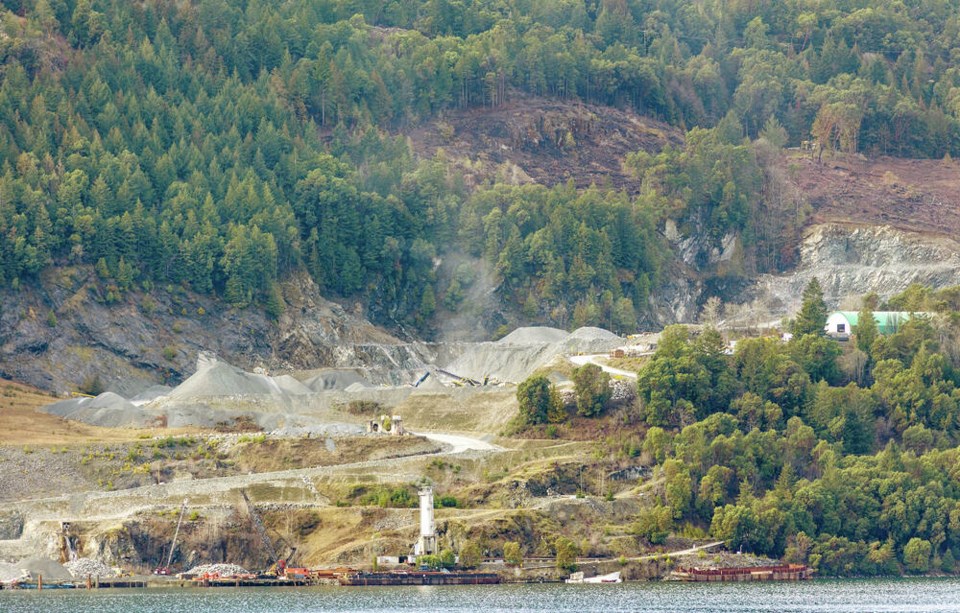The request to have expansion plans at a Bamberton aggregate quarry face an environmental review appears to have plenty of support if the number of people who logged into an Environmental Assessment Office virtual information session is any indication.
According to the Environmental Assessment Office, which was moderating the two-hour session Thursday night, more than 200 people were tied to their computer screens for the session.
Whether that amount of interest has any impact on a decision remains to be seen.
A preliminary report prepared by the office recommends declining an application for an environmental review of the project.
The draft report, subject of a public comment period until Feb. 14, recommends B.C. Environment Minister George Heyman decline to designate the Bamberton aggregate quarry expansion as a reviewable project.
The Saanich Inlet Protection Society requested the review after the Malahat First Nation applied to expand production and size of an existing quarry on Bamberton lands, extend its dock on the Saanich Inlet, and expand a soil deposit site.
The preliminary Environmental Assessment Office report, which considered the society’s concerns, said the dock extension and soil deposit site could not be reviewed, as they are substantially underway, and recommended against reviewing the quarry.
The prospect of having the Saanich Inlet Protection Society and its supporters in a virtual meeting space with the Malahat First Nation suggested it could be an evening of fireworks, but the format didn’t provide for much more than information sharing.
The question-and-answer session at the end of the evening was rendered fairly tame with a moderator reading out questions and having relevant ministry experts and the First Nation answer them.
The online session featured presentations by both the Saanich Inlet Protection Society, the Malahat Investment Corporation and the Environmental Assessment Office.
Society spokeswoman Maureen Alexander, who has been pushing for the environmental review, said an environmental assessment is not only warranted but essential on the grounds of environmental risk that could harm a fragile ecosystem.
She said the Saanich Inlet was deemed environmentally fragile 27 years ago, and she can only imagine the condition it could be in if the Malahat are allowed to log, blast and quarry for another 30 years with no environmental assessment.
The society stressed there’s no mention in the quarry management plan that it is designed for catastrophic events, shared concerns about erosion, and the already existing problems of dust, noise, and light pollution.
Josh Handysides, chief administration officer of the Malahat First Nation, told the session that the land has been an industrial site for decades and the Nation has a massive financial stake in keeping it working.
He noted the Nation has a mortgage to pay on the property and needs to produce revenue from it to cover the note.
The Nation takes pride in once again having its land under its control as it allows them to restore economic activity on its own territory, he said.
Handysides pointed out the proposed quarry expansion increases the existing disturbance area by 16 per cent, they are using the existing roads and infrastructure and the project has been designed to handle extreme weather events.
“Beyond those measures, there’s other environmental plans in place,” he said.
Matt Rodgers from the Environmental Assessment Office gave a precis of the preliminary report and stressed the decision reached in the draft was not final, though he also stressed that the belief is the permitting process in the various ministries should be stringent enough to mitigate concerns and assuage any fears.
He noted that public input is essential in helping the office come to a final decision, which will be handed to Heyman in March.
“The EAO is confident that permitting processes will adequately assess and mitigate potential effects from the Bamberton projects while providing engagement opportunities for potentially affected Nations, government agencies and the public,” he said.
In answer to a question about what possible harm having a review done could have, the Environmental Assessment Office’s Todd Goodsell said the office doesn’t consider that an environmental assessment is harmful in and of itself.
However, he noted they do take three to five years and the Malahat has indicated that the quarry expansion is necessary to continue to provide economic benefits.
“They’ve also indicated that it’s important to support the treaty negotiations underway with the province,” he said.
Goodsell said there is an existing, robust regulatory framework “for projects like this that’s intended to mitigate adverse effects.”
>>> To comment on this article, write a letter to the editor: [email protected]



